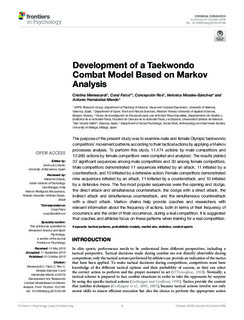| dc.contributor.author | Menescardi, Cristina | |
| dc.contributor.author | Falco, Coral | |
| dc.contributor.author | Ros, Concepción | |
| dc.contributor.author | Morales-Sánchez, Verónica | |
| dc.contributor.author | Hernandéz-Mendo, Antonio | |
| dc.date.accessioned | 2019-10-30T08:59:08Z | |
| dc.date.available | 2019-10-30T08:59:08Z | |
| dc.date.created | 2019-10-22T20:10:44Z | |
| dc.date.issued | 2019 | |
| dc.identifier.citation | Menescardi, C., Falco, C., Ros, C., Morales-Sánchez, V. & Hernández-Mendo, A. (2019). Development of a Taekwondo Combat Model Based on Markov Analysis. Frontiers in Psychology, 10. | nb_NO |
| dc.identifier.issn | 1664-1078 | |
| dc.identifier.uri | http://hdl.handle.net/11250/2625316 | |
| dc.description.abstract | The purpose of the present study was to examine male and female Olympic taekwondo competitors’ movement patterns according to their tactical actions by applying a Markov processes analysis. To perform this study, 11,474 actions by male competitors and 12,980 actions by female competitors were compiled and analyzed. The results yielded 32 significant sequences among male competitors and 30 among female competitors. Male competitors demonstrated 11 sequences initiated by an attack, 11 initiated by a counterattack, and 10 initiated by a defensive action. Female competitors demonstrated nine sequences initiated by an attack, 11 initiated by a counterattack, and 10 initiated by a defensive move. The five most popular sequences were the opening and dodge, the direct attack and simultaneous counterattack, the dodge with a direct attack, the indirect attack and simultaneous counterattack, and the simultaneous counterattack with a direct attack. Markov chains help provide coaches and researchers with relevant information about the frequency of actions, both in terms of their frequency of occurrence and the order of their occurrence, during a real competition. It is suggested that coaches and athletes focus on these patterns when training for a real competition. | nb_NO |
| dc.language.iso | eng | nb_NO |
| dc.publisher | Frontiers Media S.A. | nb_NO |
| dc.rights | Navngivelse 4.0 Internasjonal | * |
| dc.rights.uri | http://creativecommons.org/licenses/by/4.0/deed.no | * |
| dc.subject | tactical patterns | nb_NO |
| dc.subject | probabilistic models | nb_NO |
| dc.subject | martial arts | nb_NO |
| dc.subject | statistics | nb_NO |
| dc.subject | combat sports | nb_NO |
| dc.title | Development of a Taekwondo Combat Model Based on Markov Analysis | nb_NO |
| dc.type | Journal article | nb_NO |
| dc.type | Peer reviewed | nb_NO |
| dc.description.version | publishedVersion | nb_NO |
| dc.rights.holder | Copyright © 2019 Menescardi, Falco, Ros, Morales-Sánchez and Hernández-Mendo. | nb_NO |
| dc.subject.nsi | VDP::Medisinske Fag: 700::Idrettsmedisinske fag: 850::Treningslære: 851 | nb_NO |
| dc.source.pagenumber | 2188-? | nb_NO |
| dc.source.volume | 10 | nb_NO |
| dc.source.journal | Frontiers in Psychology | nb_NO |
| dc.identifier.doi | https://doi.org/10.3389/fpsyg.2019.02188 | |
| dc.identifier.cristin | 1739677 | |
| cristin.unitcode | 203,10,1,0 | |
| cristin.unitname | Institutt for idrett, kosthald og naturfag | |
| cristin.ispublished | true | |
| cristin.fulltext | original | |
| cristin.qualitycode | 2 | |

